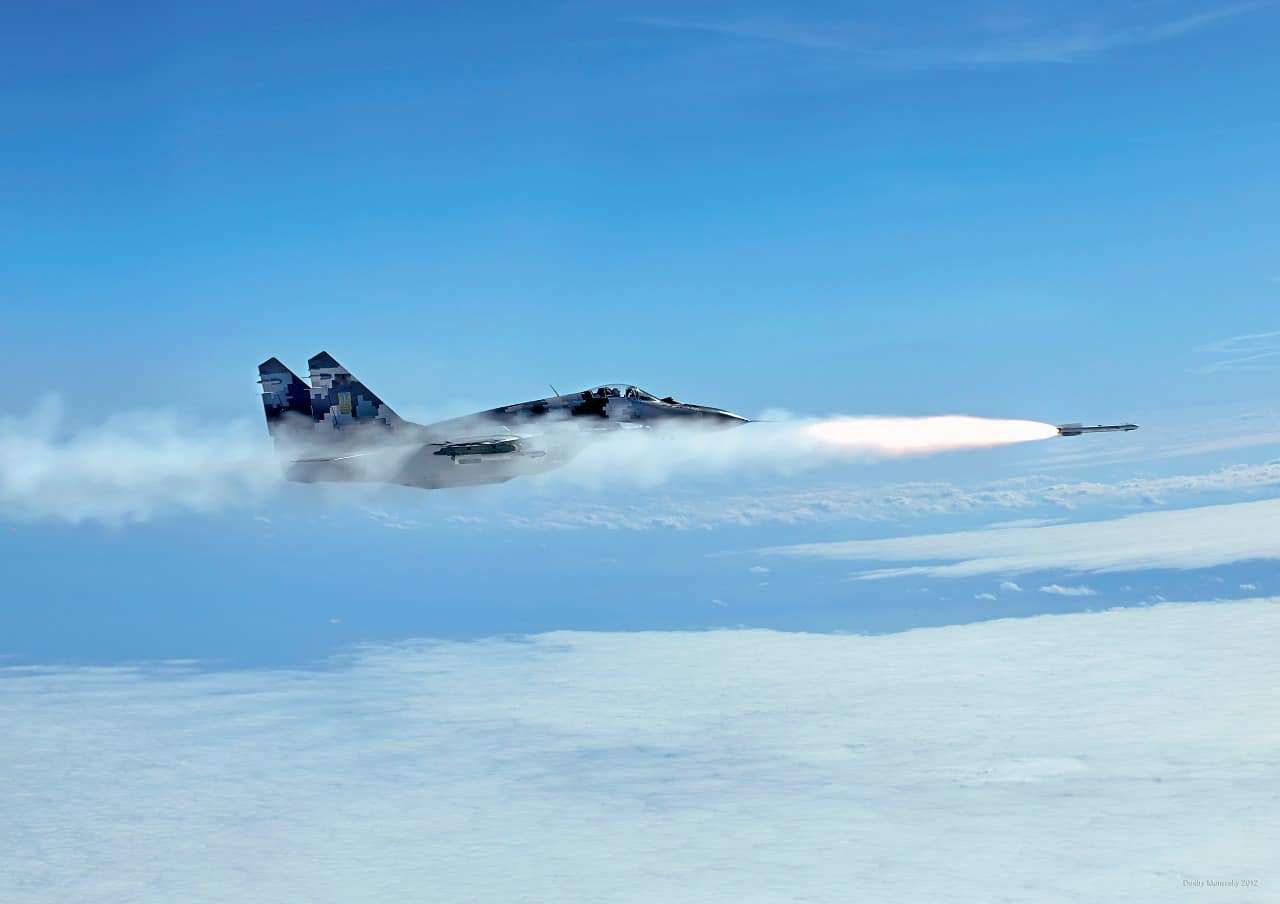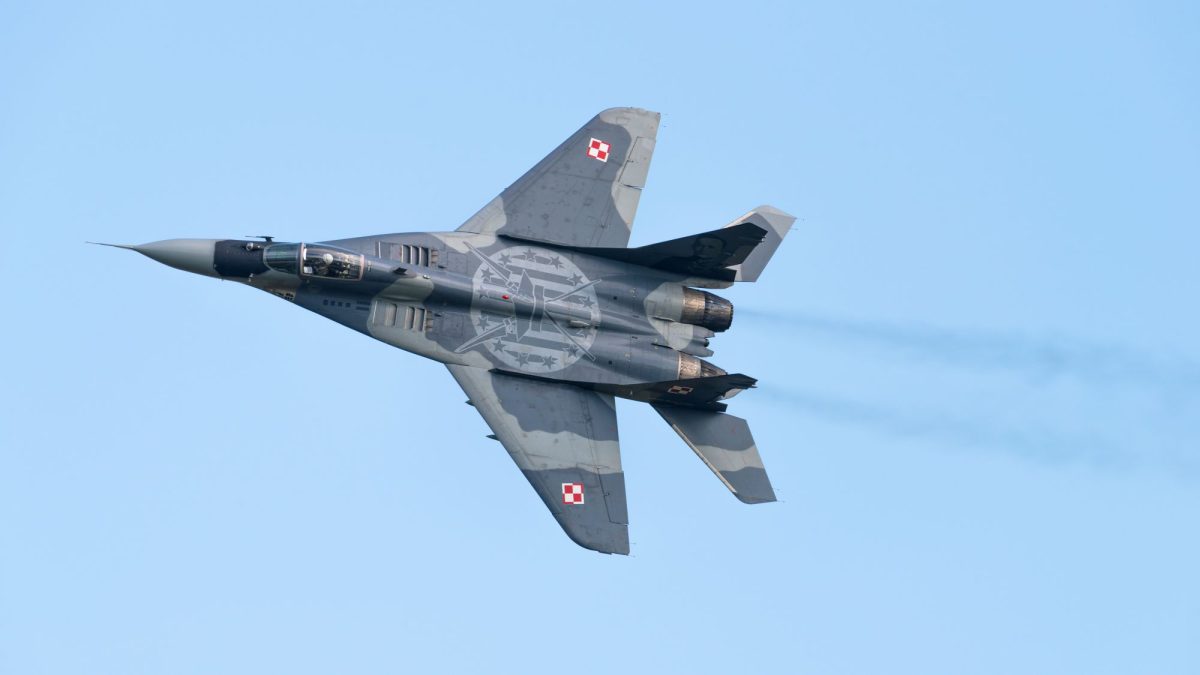The MiG-29 ‘Fulcrum’ combat aircraft, which was developed by the erstwhile Soviet Union as an answer to the American F-16 Fighting Falcon during the height of the Cold War, took to the skies for the first time 48 years ago.
The Mikoyan MiG-29, NATO reporting name “Fulcrum,” is a twin-engine, fourth-generation fighter jet developed by the Soviet Union’s Mikoyan design bureau, now part of the United Aircraft Corporation (UAC) in Russia.
The aircraft was designed primarily as an air superiority fighter but later evolved into a multirole aircraft capable of ground attack, reconnaissance, and electronic warfare.
The maiden flight of MiG-29’s prototype (designated 9-01) occurred on October 6, 1977, at the Zhukovsky flight test center near Ramenskoye, piloted by chief test pilot Alexander Fedotov.
The flight lasted approximately 20 minutes, validating the basic airframe, engines, and controls, and was followed by the flight of the second prototype (9-02) on July 3, 1978, according to publicly available information.
Interestingly, the United States spotted the MiG-29 in satellite images in November 1977, just days after the aircraft’s first flight. They saw a sophisticated, sleek-looking fighter that could challenge the best US Air Force (USAF) fighter jets of the time. Some US officials openly acknowledged that the Soviets were catching up with US aircraft technology.
The Mikoyan design bureau built multiple prototypes and pre-production aircraft for evaluation and testing. The testing covered aerodynamics, avionics, weapons, and engine performance.
The aircraft finally entered operational service in August 1983 and quickly became a vital asset in the Soviet Union’s airpower.
The MiG-29 is among the legacy Soviet combat aircraft that remain operational and deployed in combat globally to this day. In fact, it currently forms the backbone of the embattled Ukrainian Air Force. It is extensively deployed to conduct strike missions against Russia in the war that is fast inching towards its fourth anniversary.
The Development Of The Fulcrum
During the Vietnam War, Soviet planners observed that US supersonic fighters struggled against the agile MiG-17s and MiG-21s in dogfights, which further underscored the need for a new generation of fighters that prioritized air superiority, agility, and short-field performance.
The Soviet General Staff published requirements for a Perspektivnyy Frontovoy Istrebitel (PFI, or “Prospective Frontline Fighter”) in 1969. These requirements included heavy armament, superior maneuverability, advanced radar, and Mach 2+ speed.
By 1971, the PFI program split into two: a heavy fighter that was assigned to Sukhoi, which eventually paved the way for the Su-27; and the lighter Perspektivnyy Lyogkiy Frontovoy Istrebitel (LPFI) that was assigned to the Mikoyan design bureau (MiG) for a more agile, cost-effective platform, which eventually led to the development of MiG-29.
More importantly, though, the inception of the MiG-29 was linked to the overarching need to challenge American air power during the Cold War and compete with fighters such as the General Dynamics F-16 Fighting Falcon and the McDonnell Douglas F-15 Eagle.
The MiG-29 was developed to counter NATO’s growing technological edge, particularly in beyond-visual-range (BVR) combat and agile dogfighting. It was a direct response to the F-15 for air superiority and the F-16 for multirole flexibility.
Mikoyan began detailed design work on the MiG-29 (initially Product 9) in 1974. The goal was to design a lightweight, twin-engine fighter optimized for air superiority, with secondary ground-attack capabilities.
The aircraft featured a blended wing-body design with leading-edge root extensions, providing enhanced lift and high-angle-of-attack performance. The design prioritized ruggedness for rough airstrips, with auxiliary intakes to protect engines from debris.
The Fulcrum shares conceptual roots with the larger Sukhoi Su-27 but is lighter and more focused on short-range engagements. The lower cost and simpler maintenance of the MiG-29 compared to the Su-27 made it suitable for mass production as well as for export.
The National Museum of the US Air Force writes: “Although newer, the MiG-29 still lagged behind the most modern Western fighters in several important areas. For instance, the aircraft designers had little experience in either fly-by-wire controls or lightweight composite materials for airframe construction, and the first MiG-29 versions used a conventional hydraulic flight control system and an aluminum alloy fuselage. Over time, MiG designers addressed these deficiencies, and later variants of the MiG-29 incorporated some fly-by-wire controls and composite materials.”
“Nevertheless, the MiG-29 presented a formidable threat to Western pilots. The radars used on earlier Soviet fighters had been unable to distinguish aircraft flying below them from ground clutter, and low-flying aircraft could avoid detection,” it adds.
The MiG-29 was believed to be comparable to the two ace American fighters and even more advanced than they were in certain areas, as noted by the EurAsian Times in multiple past reports. The aircraft kept getting radar, avionics, and weapon upgrades.
The MiG-29 has evolved into a range of different variants over the years, with new upgrades that have expanded the aircraft’s role and made it more lethal in combat.
Some of the popular variants are: MiG-29S ‘Fulcrum C’ that featured an improved radar, multiple tracking, and enhanced payload; the MiG-29M ‘Fulcrum E’ that was a multi-role upgrade including fly-by-wire and ground-attack capabilities; the MiG-29K carrier-variant; MiG-29SMT that came with better radar, cockpit, avionics, and weapons; and the India-specific MiG-29UPG.

The MiG-29 was a lethal and agile aircraft in its heyday. Its Archer AA-11 missile was very sophisticated for the 1990s because it could lock onto targets with a helmet-mounted cueing system from greater angles than the American fighters of the same class, away from the jet’s nose.
Meanwhile, its laser rangefinder, infrared tracking sensors, and Phazotron NIIR N019 Doppler radar allowed a pilot to track and shoot at aircraft flying below him. The radar could detect a target more than 60 miles away.
Additionally, the pilot’s helmet-mounted Shchel-3UM-1 pointing system made the MiG-29 very dangerous as soon as opponents were within visual range. This essentially eliminated the need for a pilot to orient his plane toward a target and wait for the sensors on his missiles to “lock on” before launching.
With the helmet, the pilot only needed to swivel his head in the direction of the target, and the missile’s sensors would aim at it.
At close range, the MiG-29 pilot greatly benefited from this “off boresight” technique. Notably, the MiG-29 was equipped with an array of lethal missiles, including the R-27 and R-73, as well as the GSh-30-1mm cannon, providing it with a diverse arsenal for engaging both aerial and ground targets.
The MiG-29 first appeared publicly in the West during a 1986 goodwill visit to Finland, followed by displays at the 1988 Farnborough Airshow and the 1989 Paris Air Show.
When the Soviet Union disintegrated in December 1991, many former Soviet states inherited these formidable fighters, one of which was Moldova.
As previously explained in detail by the EurAsian Times, Moldova was unable to maintain or operate these aircraft due to economic difficulties and sought to sell them. At the time, Iran emerged as an interested buyer, but the US swooped in and purchased six MiG-29As, one MiG-29B, and 14 MiG-29Cs, along with 500 air-to-air missiles and all the necessary spare parts.
Once the aircraft reached the US, their airframes were deconstructed, and the capabilities of each of their components were tested. The US pilots studied, trained on, and flew the MiG-29s.
Some former Moldovan MiGs were reportedly tested in the United States, including in dissimilar air combat training (DACT) against American-built aircraft.

There have been rumors that the MiG-29 has been flown consistently for years to test and train pilots in the US. A 2022 report in Air Force Magazine claimed that, along with other Russian-built fighters, “some number” of the former Moldovan fleet are still flown for DACT.
The MiG-29 was also a huge export success. The Indian Air Force was the first international customer of the MiG-29. Separately, the Indian Navy acquired the carrier-capable MiG-29K, which entered service in 2010, for operations on INS Vikramaditya.
Other countries that purchased MiG-29 fighter jets include Algeria, Egypt, India, Iran, Iraq, Libya, Malaysia, Myanmar, Peru, Poland, Syria, Sudan, and Yugoslavia. Most of them still operate the aircraft.
The MiG-29 has participated in combat on multiple occasions and across diverse battlefields. The MiG-29’s combat debut occurred late in the Soviet-Afghan War, primarily with the Soviet Air Forces. At the time, the MiG-29s downed four Afghan Su-22 attack aircraft between 1987 and 1988.
Later, the aircraft was deployed in the Gulf War of 1991 and the Yugoslav Wars between 1991 and 1999, where it failed to make a significant impact in combat. Several MiG-29s were shot down in both these conflicts.
The MiG-29 saw action in the Kargil War between India and Pakistan. The IAF used the aircraft mainly to escort Mirage 2000s conducting precision strikes with laser-guided bombs.
The MiG-29’s high-altitude performance and IRST were well-suited for the Himalayan theater, deterring Pakistani air incursions.
“While PAF fighters did fly Combat Air Patrols (CAP) during the conflict, they stayed well within Pakistani airspace. On occasions, IAF MiG-29s armed with the deadly R-77 BVR Air-to-Air missiles were able to lock on to PAF F-16s, forcing the latter to disengage. In the absence of a PAF threat, the IAF was able to deliver numerous devastating strikes on intruder positions and supply dumps,” a Strategy Page report said after the conflict.
Russia also used the MiG-29 during the Syrian War, where it deployed the upgraded MiG-29SMT, which apparently had improved ground attack capability with guided munitions. Nonetheless, the aircraft faced significant attrition on the battlefield.
The aircraft have seen extensive action in the Russia-Ukraine war, which continues to grind on. The Ukrainian MiG-29s remain critical for air defense and strikes, with Western upgrades enhancing survivability.
In fact, the MiG-29’s agility and upgraded avionics have allowed effective low-altitude operations and HARM launches, but limited radar range and missile stocks constrained BVR engagements.
The MiG-29 remains a capable platform in asymmetric warfare to this day, but is rapidly approaching obsolescence as next-generation fighters dominate modern combat.
- Contact the author at sakshi.tiwari9555 (at) gmail.com
- Follow EurAsian Times on Google News




